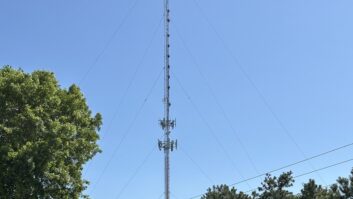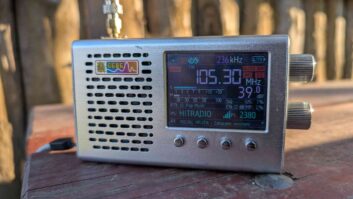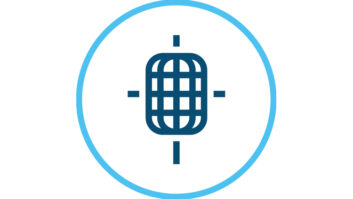There is no serious scarcity of microphone processors out there.
For example, one may choose a low-cost compressor/EQ/expander such as the $160 Behringer VX2000 or shoot big bucks on the $1,795 Omnia ToolVox. In between, there are the radio favorite Symetrix 528 and its digital sister, the 628.
Tube preamps are a valid choice, but radio has been trying to get rid of tubes for 40 years. And tube distortion on loud vocal bursts is not as romantic and nostalgic a sound as we think we remember.
So along comes Focusrite with the VoiceMaster Pro ($800 list price), offering up all the necessities like downward expansion, EQ, compression and de-essing. But the VoiceMaster Pro also throws in a bunch of digital capabilities and an instrument input, wrapped up in a knob-festooned rackmount unit sure to simultaneously confound and inspire.
Product CapsuleTHUMBS UP:
Effective compression and EQ stages
Instrument input and double mic jacks
Optional digital 24-bit output up to 96 kHz
Insert jacks for ancillary processing
THUMBS DOWN:
No memory for settings
Some features unnecessary for broadcast production
Price: $800
For more information contact Focusrite at Digidesign, its North American distributor, at (866) 362-8774 or visit www.focusrite.com
I found some features on the VoiceMaster Pro out of place for broadcast mic processing. The device is intended for more-serious studio use, hence some special features like tube distortion and harmonics enhancement. But it has the features you need for making the production room mic sound like a million.
Just be warned – there are a lot of buttons and knobs on this baby, and no memory positions for recalling your favorite setting.
Hi, Mike!
First item you may notice is the mic input on the front panel. Every other processor made has the XLR input on the back.
Don’t get ahead of me. There is also an XLR input on the rear panel as well. Some studio requirements dictate the ability to plug into the front.
The mic input features 48V phantom power, a phase reversal switch, an input gain pot and a variable low-cut rumble filter which dials in a nice steep 18 dB/octave shelf anywhere from 30 to 400 Hz.
The phantom power is a welcome feature. My evaluation mic for this review is a prototype condenser mic from Lawson, targeted primarily to the voiceover performer and so new it didn’t even have a model designation yet. Mics such as these require external power and the VoiceMaster Pro was there.
Musicians at the station might be pleased to know they can plug an electric guitar or bass into the unit without the need for an impedance converter or direct box. Part of my review explored that as well.
First stop: the Optical Expander. Basically a noise gate, it offers control over threshold and close (release) time. It’s ideal for rooms with hissy HVAC or crummy acoustic seals to the outside world.
For all it does, I noticed some grittiness as the expander was closing. This was not as prominent on voice as it was when I played long sustained chords into it from a Danelectro electric guitar.
Next door to the right is the first feature to make me go, “Hah?” Vintage Harmonics, the manual claims, adds extra emphasis and sparkle to the signal path, much in the way we used to record cassettes with the Dolby button engaged, then play them back with the Dolby turned off.
This emphasis trick used to make tape demos sound shiny and full of life as they went out the door to a client.
Vintage Harmonics allows two frequency ranges to be affected: the mids, which peak at 3 kHz, and the highs, which top off at 18 kHz. Threshold controls set the amount of boost that takes place per band, dependent on level. When engaged and properly tuned, the result is a voice part that has a compressed feel but without the mushed high end normally experienced with conventional limiting.
One handy item here is the ability to place the Vintage Harmonics stage pre- or post-compressor. This way, you may choose to have the upcoming compression stage affect the pumped-up signal or not.
I said “hah?” to this feature only because most multiband processing such as this can be done post-production in the DAW. In live real-time use, the aforementioned Danelectro takes on a jangly ’60s Byrds-type tone when this stage is engaged. For mics, the usefulness of this feature is best left up to your own needs.
More next door
Continuing to the right, we find the Optical Compressor, the magical component that turns our thready, raspy announcer voices into those of Norse gods. Every good mic processor has to have a compressor, and the VoiceMaster Pro does not disappoint.
The controls are fairly simplified: Threshold, Release Time and Makeup Gain to restore what was dipped out during compression. A Hard Ratio button (known to dbx fans as “hard knee”) tilts the compression response severely, turning lots of dynamics into almost none at all.
The Slow Attack button delays the onset of the compression action, leaving in some of the original attack and causing that thup effect with which we are familiar. When using a mic track with some reverb, that slow attack thup causes the reverb to bloom nicely.
This stage includes a pre-post button, placing the compressor before or after the upcoming EQ stage. With the interaction of the Vintage Harmonics’ placement in the audio chain, this could get confusing for some.
By the way, you actually can insert reverb or whatever you wish prior to processing through the rest of the VoiceMaster Pro. Insert Send and Receive jacks on the rear panel tap the signal path after the mic preamp and before the first stage. Here you may patch in whatever external processor is desired.
The Tube Sound stage is another “hah?” item for me. It adds tube- or tape-type distortion, dropping in second — through fifth — order harmonics as the dials are turned. Musically, this stage did some good dirty work on the electric guitar I plugged in to the front, and the LED that gradually changed color from blue to red was a nice touch.
For the microphone though, my feelings were mixed. I like a clean, undistorted mic path all the way to the audio editor, where I can add in as much synthetic distortion as I want. I probably would not get a lot out of this particular stage for my own work.
Which does finally bring us around to the Voice Optimized EQ.
EQ 4 U 2
The VoiceMaster Pro lacks the wide sweeping EQ offered on units such as the Symetrix 528. But what it does have is claimed to be optimized for the human voice.
Instead of forcing us to memorize frequency bands and what they do for us, the VoiceMaster Pro uses subjective frequency ranges called Breath, Warmth, Mid and Absence.
The switchable Breath control offers nice boost and cut to frequencies above 10 kHz or 16 kHz (no doubt to freak out your dog). The Mid knob centers around 1.3 kHz to work the upper midrange of the human voice, and Warmth acts on lower frequencies from 120 to 600 Hz.
I like the Absence knob. At first, you wonder what is missing. Something must be missing if there is a control called Absence, right? What it does is drop a specific frequency range by up to -10 dB, centered around 3.9 kHz – a region that causes some harshness to the recorded voice. It’s that range you’ve always noticed, but just couldn’t find with the sweepable filter. Focusrite did the work for you.
The Q is not variable on the Absence control, which is okay. Dial it all out and sort it out later inside the DAW.
Lastly, there is the de-esser, which affects overly sibilant sounds from 2.2 to 10 kHz. Very effective, especially when using a sensitive condenser mic that reads everything in the room.
And then there’s that cool blue VU meter. You just have to see it in action.
Digits
The VoiceMaster Pro also has a 24-bit/96 kHz A-D option for $250. You can send a 24-bit signal directly into your digital console or workstation at 44.1, 48, 88.2 or 96 kHz sample rates. A Wordclock BNC connector allows the VoiceMaster Pro to be clocked by a house digital standard.
The unit I checked out shot a nice clean signal directly into my home Cool Edit machine via a Hercules soundcard with S/PDIF input.
If you want to minimize the amount of back-and-forth D/A and A/D conversions in your studio, this is a good place to start.
Of some limited use to radio production types is the latency-free monitoring section. This strives to eliminate the latency experienced when talent must perform to prerecorded tracks on a digital system and hears their own voice delayed in the headsets as it passes through the digital recorder.
Because we tend to record one item at a time and work out the synchronization on the editor, the latency issue is more of one for singers and musicians than for radio production.
The wrap
The price and feature set of the VoiceMaster Pro make it a decent value and a good performer. It does what it was designed to do and offers lots of control over how you want your mic to sound.
It is priced a lot higher than the budget stuff you may have been eyeing, and it even checks in pricier than our old buddy, the Symetrix 528. One should remember that the Focusrite is a Class A device that costs more to make. Whether or not the extra features like the distortion stages are worth it for your operation are up to you.
That shiny aluminum front screams “look at meeee” when racked up along with the black-faced Denon and Tascam decks and Sony MD units; but a little pride cannot be all bad.
The Class A discrete preamp may run warm; indeed, the manual calls your attention to it. But what doesn’t run warm in the studio rack? Leave enough space around the unit for airflow and all is well.
Please don’t scream that the VoiceMaster Pro has no MIDI jacks and its parameters cannot be modified by MIDI commands. It is radio, Jack; why on earth would we need that?
Last, a small nit: why a power switch? We generally leave components like this on all the time in the rack.
If you have the money, you are welcome to check out the unit’s big brother, the Focusrite ISA220 Session Pack channel strip. That baby will set you back about $1,500, which makes the VoiceMaster Pro seem quite the bargain.







